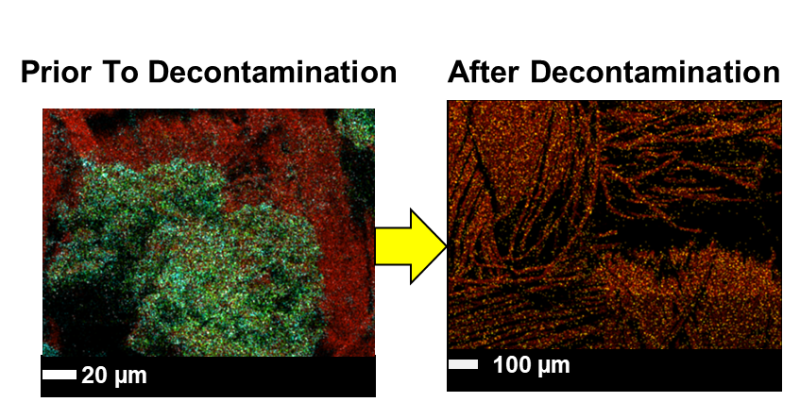Newsletter
Many of PSI’s technology platforms are dedicated to making people safer – from health, climate, energy, or security threats. We are proud that we are also working to improve the safety of the first responders who put our safety ahead of their own. This newsletter describes a collaboration with the DoD and local firefighters for improved safety in their operation.
PSI Team Works to Improve Firefighter Decontamination Technology
Physical Sciences Inc. (PSI), in collaboration with the Illinois Fire Services Institute (IFSI), Bergeron Protective Clothing (BPC) and the Lawrence Fire Department, and with the support of Army Research Lab (ARL), is developing a novel detergent and field application kit for improving firefighter decontamination practices.
Firefighting is an inherently dangerous job. In addition to the physical hazards, many airborne chemicals produced during building fires are known carcinogens. It has been shown that exposure to these chemicals is the underlying cause of increased cancer risk among firefighters (up to two times greater cancer risk relative to the general population). Polycyclic aromatic hydrocarbons (PAHs), volatile organic compounds (VOCs), and heavy metals (HMs) are the three major classes of carcinogens present in smoke. These chemicals adhere to firefighter turnout gear (boots, helmets, and jackets) in the process of extinguishing a fire. There is no universal methodology to decontaminate turnout gear, and strategies vary by organization and locale, often leading to inconsistent and unproven decontamination practices.
PSI successfully executed a research program in which we formulated a detergent that met all objectives for efficient PAH, HM and VOC removal. PSI’s key innovation is the combination and formulation of three detergent components, each individually selected to target a different contaminant class: a PAH solubilizer, a heavy metal scavenger and a base soap to produce a poly-aromatic and heavy metal removal (PAHM) detergent. PSI identified components that are shown to be compatible with aqueous cleanup processes, non-toxic, non-corrosive, environmentally friendly, inexpensive, and comply with NFPA 1851, the National Fire Protection Association’s governing standard for gear maintenance and decontamination.

Scanning electron microscope images showing a piece of firefighter turnout gear (left) before decontamination and (right) after decontamination. Heavy metal contaminants are indicated by the green and blue traces. No heavy metals are detected after the decontamination was performed with the PSI detergent
The team is now one year into the Phase II program. We have optimized the detergent formulation, demonstrated that the detergent has no negative impacts on firefighter gear performance, and are now working with third parties to verify performance. The next year of the program will focus on best practices for implementation of the detergent and commercialization of the new formulation. We are working with our partners to demonstrate the detergent efficacy by testing it in the field.
If you are interested in learning more about this exciting project, contact Dr. David Gamliel at dgamliel@psicorp.com

PSI staff members work with Firefighters at the Lawrence Fire Department to better understand the complexities of firefighter decontamination
Contract News
PSI recently received the following research contracts from The National Aeronautics and Space Administration (NASA):
Photonic Integrated Raman Spectrometer (PIRS) – PSI, in collaboration with an academic partner, is developing a Photonic Integrated Raman Spectrometer (PIRS) for low-SWaP spectroscopy applications. A silicon nitride photonics platform will be used to develop a dual-stage spectrometer that enables simultaneous high bandwidth and high resolution spectroscopy with direct readout. The on-chip spectrometer developed within this program is a key component for low size, weight, and power spectroscopy applications including fluorescence, absorption, and Raman spectroscopy. These devices will form key components of ultra-compact chemical sensors capable of detecting biomolecules and hazardous chemical agents.
Self-Propelled Energetic Electron Dispensers (SPEEDs) for Deorbit Applications – PSI is developing passive and active enhancements to existing heritage electrodynamic tether smallsat deorbit systems. Passive coatings based on flexible materials with negative electron affinity-enhanced triple point electron emitters will enable deorbit of smallsats and other payloads during end-of-life at altitudes up to 1200km by increasing the passively generated current through electrodynamic tethers. The innovation is applicable to all smallsats, and possibly larger payloads such as spent rocket stages. Related technology is being used to develop cold cathode electron emitters to drive higher, controllable currents through existing tether systems. The application is controlled, rapid, propellantless deorbit of payloads, minimizing further pollution of low Earth orbit and mitigating risk of spacecraft collisions.
Deep UV Raman Spatial Heterodyne Spectrometer for Depth Resolved Small Body Ice Core Analysis – PSI is developing a compact, solid-state ultraviolet spatially offset Raman sensor with a diagnostic core retrieval system. The UV Raman sensor, currently under development at PSI, utilizes a UV laser (266 nm) that has been developed by Q-Peak. The current UV Raman design will be modified to include a digital micromirror device in order to collect spatially offset Raman signal at varying penetration depths within a material. This system will be paired with a small core retrieval system to allow for initial diagnostic testing of areas on small bodies, such as comet nuclei, to determine where larger cores should be collected and returned to Earth.
Ground Based Uplink and Beacon Laser for Long-Range Communications – For deep space optical communications at astronomical distances such as Mars and beyond, a multi-kW average power laser that can be coded to send data is needed. Optical communication will revolutionize space-based science and exploration capabilities by supplying data rates up to 100 times faster than the currently used radio frequency based systems. PSI is developing a simple and innovative fiber design that can produce > 3 kW of average power and 6 kW of peak power at 50% duty cycle. This ability will generate the optical power efficiently, aim the narrow beam accurately enough to illuminate a receiver on Earth, and collect and detect the received optical signal with minimal loss after passing through the atmosphere. A fundamental concept of operation is the deep space transceiver that uses an uplink beacon from Earth as a reference for pointing the downlink.
Photonic Integrated Circuit Assisted Single Photon Detectors (PICA SPDs) – PSI and our academic partner will develop Photonic Integrated Circuit Assisted-Single Photon Detectors (PICA-SPDs) to increase the bandwidth and timing resolution of single-photon detectors (SPDs). Realizing low size, weight and power (SWaP) SPDs with high saturation-rates and high timing-resolutions are critical for deploying of quantum technology in space. To overcome the challenge of increasing both the timing resolution and saturation rate of SPD arrays, our unique active-approach leverages high-speed, low-loss PIC modulators. The development of quantum communications and networks are a key technology to enable secure communication, sensor arrays, and quantum computer networks. PSI’s technology will allow NASA to increase the bandwidth of both free-space and fiber quantum links. High saturation rate and low-jitter single-photon detectors are also a general-purpose tool for a range of applications, from quantum networks and communication links, to imaging and healthcare applications.
PSI also recently received the following research contracts from The Missile Defense Agency (MDA):
C/SiC Foam Pintles – PSI will develop an innovative composite pintle architecture to meet high temperature and high strength needs of future MDA systems. The architecture combines existing high temperature fiber-reinforced ceramics with a novel insulating material. The resulting element will have high axial and bending strength at the relevant operating temperatures, but axial low thermal conductivity, protecting the valve actuator for the extreme heat of the engine operation. PSI’s pintle architecture will enable higher temperature fuels to be used in rocket motor systems to enable higher speed and/or greater range. Successful demonstration of the insulator in pintles will be the first step toward broader insulation applications in composite hypersonic vehicle bodies. Applications in these vehicles include build-ups in aeroshells, structural insulation and thermal protection systems for embedded electronic systems.
IM Compliant High-Energy Hydride Propellants – PSI is developing safe Insensitive Munitions (IM) Compliant, high performance solid rocket propellants for advanced interceptor capabilities with significantly increased delta-velocity. PSI’s innovative propellant formulations capitalize on novel ingredient technologies that provide for 10% increase in Isp relative to state-of-the-art aluminized hydroxyl-terminated polybutadiene / ammonium perchlorate composite propellants. Analysis of boost stage and upper stage propulsion systems using PSI’s propellant show that up to 12.5% and 20% performance improvements can be achieved, respectively. The successful development of PSI’s IM Compliant High specific impulse (Isp) propellant formulations would be directly applicable to all ongoing DoD propellant and munition programs aimed at high burn, extended range, and decreased time-to-target. PSI’s high-energy fuel ingredient could also be of benefit to air-breathing propulsion technology including solid fuel ramjets. The increased ramjet propulsion performance, provided by PSI’s fuel technology, would enhance operational capabilities in the form of extended range and faster time-to-target.
For more contract news, visit www.psicorp.com/news.




